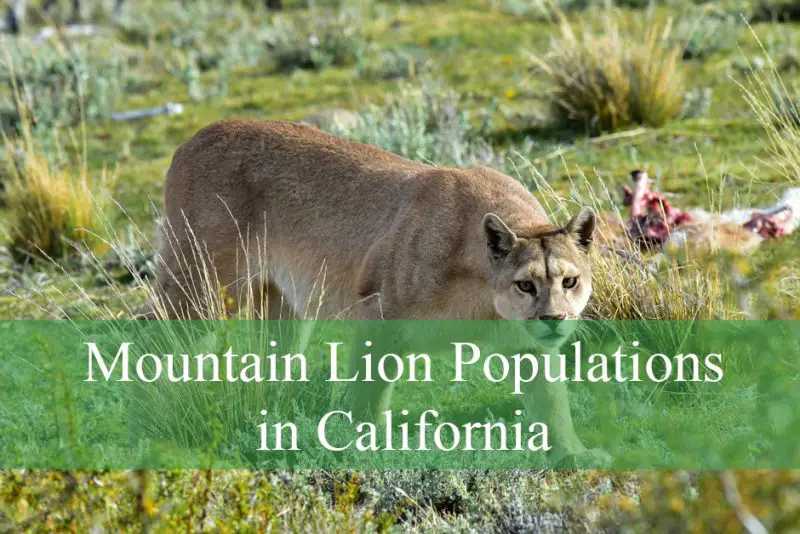Mountain lions in California, scientifically known as Puma concolor, all belong to a single species. However, due to California’s diverse geography and increasing human development, these big cats have become separated into distinct regional populations. While not different subspecies, each group has developed unique behavioral traits and genetic variations shaped by their environment.
Across the state, mountain lions inhabit coastal ranges, rugged mountains, and remote forests. Some live in areas with heavy human activity, while others roam more isolated wilderness. These varying conditions have led to the formation of three well-known population groups, each facing different challenges in terms of survival, territory, and gene flow.
In this article, we’ll explore three of the most recognized regional populations of mountain lions in California. With photos and identification tips, you’ll learn how these apex predators adapt to their environments—from the isolated cougars of the Santa Monica Mountains to the freer-ranging lions of Northern California.
Regional Types of Mountain Lions in California

Santa Monica Mountains Population
The Santa Monica Mountains mountain lions are among the most studied yet most threatened cougar populations in California. These animals are medium to large-sized carnivores, with adult males typically weighing between 120–150 pounds (54–68 kg) and females around 70–90 pounds (32–41 kg). Their bodies are long and muscular, with a tawny coat, a white underbelly, and a thick tail with a dark tip. Physically, they appear no different from other cougars in the state, but their genetic makeup is increasingly limited due to extreme isolation.
This population is hemmed in by major freeways like U.S. Route 101 and vast urban sprawl in Los Angeles and Ventura counties. As a result, these mountain lions are genetically isolated, leading to inbreeding and a high risk of health problems such as kinked tails, heart defects, and reduced fertility. GPS tracking studies have shown that many of these cougars are unable to leave their small territories, and territorial conflicts between males are frequent due to space constraints. Behavioral adaptations include being more nocturnal and avoiding developed areas whenever possible.
Their diet primarily consists of deer, which are abundant in the region, but they also prey on smaller animals like coyotes, raccoons, rabbits, and even domestic pets when natural prey is scarce. They require large home ranges, often over 100 square miles for males, but urbanization has severely limited available territory. Road mortality is one of the leading causes of death for this group, as mountain lions attempt to cross busy freeways in search of mates or food.
In California, the Santa Monica Mountains population is restricted to a relatively small, fragmented area in Southern California. Their habitat includes coastal chaparral, oak woodlands, and steep mountain slopes. Conservation efforts, such as the construction of the Liberty Canyon wildlife crossing, aim to reconnect this isolated group with other populations to prevent extinction due to genetic collapse.
Santa Cruz Mountains Population
The Santa Cruz Mountains population of mountain lions is located in the coastal ranges of the San Francisco Bay Area, stretching through San Mateo, Santa Cruz, and parts of Santa Clara counties. Adults resemble other California cougars, with muscular builds, long tails, and pale brown coats. Males typically weigh around 130 pounds (59 kg) and females around 80–90 pounds (36–41 kg). These cougars are often elusive and rarely seen, despite living near one of the most densely populated regions in California.
This population has been the subject of multiple research studies, which have revealed that habitat fragmentation, although not as severe as in the Santa Monica Mountains, is still a significant issue. Urban development, roads, and human activity have created bottlenecks in their movement. However, the Santa Cruz group has maintained better genetic diversity compared to their southern counterparts, thanks in part to occasional dispersal from the Diablo Range and surrounding mountain corridors.
Like other mountain lions, the Santa Cruz cougars are apex predators whose primary prey is black-tailed deer. They also consume smaller mammals such as skunks, opossums, and rodents, and are known to take livestock or pets in rural-urban fringe areas. They are solitary and territorial, with males requiring territories of up to 150 square miles. These mountain lions are mainly crepuscular and nocturnal, avoiding daylight activity near populated areas.
In terms of habitat, the Santa Cruz Mountains offer dense forest, coastal scrub, and redwood groves—ideal for stalking prey and sheltering cubs. The topography provides some degree of isolation, but ongoing expansion of Bay Area suburbs threatens long-term habitat connectivity. Wildlife corridors and underpass structures are being considered to help facilitate safer movement and prevent population isolation in the future.
Eastern Sierra and Northern California Populations
The mountain lions of the Eastern Sierra and Northern California represent the most robust and genetically diverse cougar populations in the state. These animals inhabit vast mountainous regions, including parts of the Sierra Nevada, Cascade Range, and remote forested areas in counties such as Shasta, Lassen, and Modoc. They are physically similar to other California mountain lions but often appear slightly larger, likely due to greater prey availability and less human disturbance.
This population enjoys expansive home ranges with relatively intact habitat, allowing for healthier breeding and dispersal. Unlike the isolated southern populations, mountain lions in Northern California can roam across large tracts of public land, national forests, and wilderness areas. This mobility allows males and females to interact over greater distances, maintaining genetic diversity and reducing the risks associated with inbreeding. These lions are less likely to come into direct contact with humans and therefore suffer fewer vehicle-related fatalities or conflicts.
Eastern Sierra and Northern California cougars primarily prey on mule deer and elk, but they will also hunt smaller mammals such as hares, porcupines, and turkeys. With large ungulate populations in the region, these cougars rarely need to approach human settlements for food. Their behavior is typically shy and elusive, avoiding people when possible and favoring rugged terrain for travel and hunting. They establish and defend large territories using scent-marking and vocalizations such as growls and screams.
In California, these mountain lions are found in more remote and undeveloped areas, including Lassen National Forest, Modoc Plateau, and the eastern slopes of the Sierra Nevada. Their habitats range from pine forests and alpine meadows to volcanic highlands and desert edge zones. Because of the relative isolation and low human density in these areas, this population is considered the most stable in the state, though they still face risks from wildfires, habitat loss, and state-sanctioned depredation permits.
How to Tell California’s Cougar Populations Apart
While all mountain lions in California belong to the same species (Puma concolor), the three regional populations differ in notable ways due to geography, human impact, and habitat structure. Physically, these cougars look similar—muscular bodies, tawny coats, long tails with black tips—but differences emerge in behavior, movement patterns, and health.
The Santa Monica Mountains population is the most isolated, often confined by freeways and urban development. These cougars show signs of inbreeding such as kinked tails and heart defects, and their home ranges are smaller due to limited space. In contrast, the Santa Cruz Mountains population has slightly more mobility and genetic variation, though still impacted by development. They display relatively normal behavior but occasionally enter suburban areas. The Eastern Sierra and Northern California mountain lions live in remote, rugged environments and enjoy the greatest freedom of movement. These lions exhibit more natural behaviors and maintain healthier gene pools due to interconnectivity with other populations.
Habitat differences also help distinguish these groups. Santa Monica lions inhabit coastal chaparral and oak woodlands hemmed in by roads; Santa Cruz cougars navigate redwood forests and coastal scrub near urban edges; and the Sierra/Northern California population roams wide-open forests, alpine slopes, and volcanic terrain. Understanding these distinctions helps researchers track their health, movement, and conservation needs more effectively.
Why Regional Mountain Lion Populations Matter
Regional mountain lion populations in California are ecologically vital. As apex predators, they help regulate deer populations, prevent overgrazing, and contribute to biodiversity by supporting prey balance. Each localized population plays a unique role in its ecosystem, tied closely to the health of native vegetation and prey species in its specific habitat.
The isolation of populations like those in the Santa Monica Mountains presents a major risk: local extinction. When populations become genetically trapped with no ability to breed with outside groups, genetic diversity collapses. This can lead to reduced fertility, disease vulnerability, and even physical deformities—factors that threaten the long-term survival of the group.
Maintaining regional genetic diversity is critical for the resilience of the species as a whole. If one population disappears, it can’t easily be replaced. A robust network of interconnected populations ensures that mountain lions can adapt to changing environments, disease pressures, and shifting prey patterns. Thus, conservation efforts must focus not just on protecting individuals, but on maintaining connectivity between populations.
Regional mountain lions also serve as indicators of broader environmental health. When cougars thrive, it often means the ecosystems they inhabit are functioning well. Protecting these predators supports countless other species and preserves California’s wild character.
Mountain Lion Conservation in California
Conservation efforts for mountain lions in California have intensified in recent years, as researchers and wildlife advocates recognize the risks posed by urbanization and fragmentation. Key strategies include preserving large natural habitats, creating wildlife corridors, and enforcing protections under state law. In California, mountain lions are classified as a “specially protected mammal,” which limits hunting and encourages habitat conservation.
One of the most significant conservation projects is the Liberty Canyon Wildlife Crossing, currently under construction over U.S. Route 101 in Los Angeles County. This crossing is designed to reconnect the isolated Santa Monica Mountains population with other cougar populations in the Santa Susana and Simi Hills. Once completed, it will be the largest wildlife bridge in the world and a model for urban wildlife conservation globally.
Despite progress, many challenges remain. Vehicle collisions continue to be a leading cause of death, particularly for dispersing juveniles. Wildfires, drought, and urban sprawl further threaten available habitat. Additionally, depredation permits—issued when mountain lions prey on livestock—can still result in legal killings. Balancing human interests with wildlife needs is an ongoing struggle.
Looking ahead, conservationists are calling for expanded habitat protections, more wildlife crossings, and public education campaigns to reduce conflict. Technological tools like GPS tracking, camera traps, and genetic analysis are helping researchers monitor population health. With sustained effort, California can serve as a leading example of how urban and wild spaces can coexist—for the benefit of cougars and people alike.






